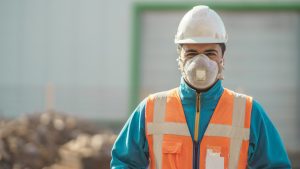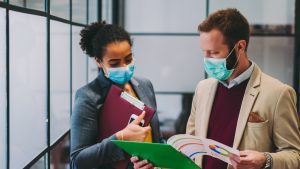
Alison Margary, British Occupational Hygiene Society, explains why the pandemic’s use of PPE should make us re-evaluate disease prevention.
COVID-19 has introduced the acronym PPE (personal protective equipment) to many people for the first time. However, the concept of creating a protective barrier for the individual has been around for thousands of years. Armour was PPE for warriors. Pliny the Elder in the first century described a primitive respirator to protect miners from lead oxide. Charles de Lorme’s plague doctor suit with glasses, a beak full of herbs and a rod to enforce social distancing has become iconic in drama and television.
To this day, thousands of workers across the world, often undertaking heavy manual jobs in mines, on building sites and in proximity to toxins spend their days (or nights) in PPE. It is treated as a necessary evil by many blue-collar workers. Internationally, adequate PPE is a protection to be aspired to by many others: the aspiration to prevent work-related respiratory disease which, according to the Health and Safety Executive, in the UK alone, accounts for 1.6 million people suffering from a work-related respiratory illness each year and 13,000 deaths from these illnesses.
The rise of the mask
The pandemic has demonstrated to millions of us the discomfort and inconvenience of face coverings. The medical profession, who have typically focused their concern on protecting vulnerable patients from infections that they may pass on have had to swap the relative comfort of the occasional use of fluid resistant surgical masks for gruelling shifts in tight-fitting respirators, gowns and gloves. In truth, the ubiquitous face-covering and the fluid resistant surgical mask are not PPE, but a means of “source control”. Put simply, they are primarily designed to prevent the wearer from infecting others and their protective status is secondary. However, the experience of having to wear face coverings in public and of professionals like doctors and dentists having to wear PPE has resulted in a widespread awareness of how restrictive and unpleasant this can be. Social media was flooded with pictures of welts on the faces of young nurses and images of medical staff in a wide array of technical equipment. When looking at the situation from the perspective of public understanding, the PPE response to COVID-19 has highlighted inequalities and inadequacies in our approach to health protection for workers, albeit in an unfocused way. It should force us to start asking some fundamental questions about our approach to worker health protection in general and the role of PPE.
At the outset of the pandemic, as the enormity of the risk emerged, the habitual tools of disease management were not available. Effective treatments of these new variants eluded us, while isolation to prevent the movement of the disease from one country to another was, for the most part, impossible. Again, it highlighted an inequality. In less developed countries, diseases are often regarded as endemic – even if they are curable and preventable. In countries with good health infrastructure, disease affects the minority and can be the subject of focused treatment and isolation. COVID-19 put those with prized health services in the position of having more to lose as the peril of health services being overwhelmed became a critical national issue. For a moment in history, the daily lived experience of the less developed country became the acute horror of the affluent nations. The critical national asset of clinical staff emerged as the visible front line of the fight against COVID-19. Behind them, perhaps less visible, all the other essential infrastructure was at risk. Unusually for healthcare staff, the need to protect themselves from infection became an immediate priority – even for health professional bodies. PPE, which occupational hygienists refer to as the last resort, became the first response.

The PPE response to COVID-19 has highlighted inequalities and inadequacies in our approach to health protection for workers.
A cultural shift
Out of the cultural shift to PPE as a first response emerged several new issues. The absence of a clear international standard for Respiratory Protective Equipment (RPE) caused havoc globally. The inadequacy of PPE supply for people who did not fit the model of a standard 70kg man was never so evident. The reliance on a culture of disposable PPE, creating a disaster for our seas and waterways, with increased dumping and the elevated presence of microplastics will be an emerging legacy that we must soon confront. As the pandemic develops stark differences have emerged in occupation-related statistics for different sectors of the economy, with casual labour in logistics, personal services (including social care) and customer-facing roles, bearing the brunt of infection, poor outcomes and death. While lockdowns and PPE made the headlines, other organisations looked at how to enlist what occupational hygienists call the hierarchy of controls: to use testing, management of people, ergonomics, administrative practices, and other solutions to enable social distancing or the containment of the potential for spread within workplaces. Whole complex organisations were able to weather the pandemic while still delivering the services to keep countries operational and not always with an excess use of PPE.
At some point, perhaps soon, the mandate to wear face coverings will cease to be a widespread phenomenon. Hospitals will have such low COVID-19 rates that PPE will not be a regular feature of workwear. While something as profound as the experience of the last year and a half will live on in international cultural memory, perhaps PPE will sink back into the obscurity of something that exists primarily for the blue-collar worker. We will ignore that many of the health hazards that are endemic in the workplace may be preventable, perhaps we will smile or wince as we pass a construction worker wearing an (often ineffectual) dust mask and remember the days when they could not be had for love nor money and everyone wanted one. We cannot let the issue of PPE and especially respiratory protection slide into some remote nightmare recollection. If we do then we condemn thousands to work in conditions where a slip of the mask, a glitch in supply, a failure to fit or a lack of awareness will result in lingering, malicious diseases like cancer.

PPE needs to be developed to reflect the ‘personal’ – fitting according to gender and ethnic group.
Lessons to learn
If we do not change the way in which we view PPE we will have failed to learn an essential set of lessons, including that:
- PPE is a protection of last resort. We need greater and more effective prevention methods which requires planning and forethought;
- PPE will not save us from systematic and widespread risk, even when people deploy it properly. And when it fails, which it frequently does, it means the protection it provides also fails;
- PPE manufacturers and regulators need to agree a common framework of standards to enable a global market that responds to needs wherever they are in the world;
- PPE needs to be developed to reflect the ‘personal’ – fitting according to gender and ethnic group, such as a wider variety in glove sizes beyond the standard small, medium, and large, or masks that fit smaller or differently shaped faces;
- PPE needs to be sustainable and reusable with effective methods of cleaning and disinfection – it should not be the cause of a different crisis in the environment;
- PPE needs to be seen as an indicator of the failure of all other protections, such as distancing, ventilation and cleaning, not the point of aspiration; and
- PPE should not be a marker of the haves and have-nots – everyone is worthy of the collective protection of the right mask with a good fit, gloves and gowns where needed.
PPE is an indicator in so many ways of the maturity of an organisation or country in terms of its response to health exposure risks. It does have a role as a secondary line of defence and in some situations is unavoidable, essential and effective, e.g. in emergency response. However, a nation or business which is content to see large swathes of its workforce in PPE as the primary control has probably failed to see something important. The threshold of health protection should not be at an individual level, but one of collective obligation and engagement for all of its people. For many, seeing the end of pictures of healthcare workers in PPE as anything other than a secondary control will be the symbol of the defeat of COVID-19. We should then move our gaze to factories and building sites to watch for the disappearance of the need for respiratory protective equipment. That will signal the end of the immediate personal risk that has been the daily peril of so many human beings who work behind a mask.
Alison Margary
President
British Occupational Hygiene Society
The Chartered Society for Worker Health Protection
www.bohs.org
This article is from issue 18 of Health Europa. Click here to get your free subscription today.








